The Ugandan teachers participating in our Teacher Exchange Program (TEX) have officially started their team-teaching. Six weeks, six teachers, six schools, six amazingly different experiences. We have been following two teachers in particular, Florence and Samuel, and have picked their brains on their experience thus far and tracked their movements in pictures. Fall in love with them as we have, and get caught up on what they’ve been doing/learning/seeing as they teach in U.S. classrooms.
First, a little background: Ayella Florence Oroma has been teaching English and literature in Uganda for over 20 years. Opiyo Samuel has taught chemistry, mathematics, and computer studies at Anaka Secondary School in Uganda since 2005. In addition to being hosted by former Teacher Exchange participants during their stay in the U.S., the Ugandan educators team up with American partner teachers in the classroom, allowing for innovative in-class collaboration.
Ok, now introducing [drumroll] Florence along with a peek inside her journal.
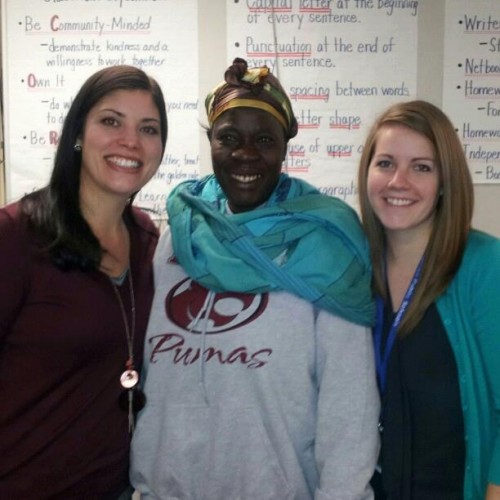
This is Florence (middle) with two partner teachers
January 7: First time at Powell Middle School. It was a warm welcome for me to the new environment. I was overwhelmed by the building, due to the large size and how nice it is.
January 8: It was the first day for the students. They were all welcoming and eager to learn from me.
January 10: Today I was invited by the Assistant Principal to speak to the entire 7th grade student body about education. I mentioned about building the foundation of education like the roots of a tree.
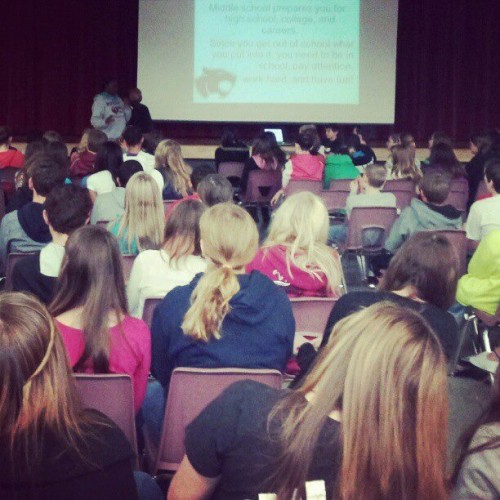
Florence speaking to the 7th grade
January 11: The school day began well. During a Humanities lesson we looked at Rights and Privileges, and compared them in America and Uganda. I ate lunch with two students and then it began to snow. There was snow everywhere and the temperature was so cold but the girls took me outside so I could touch it and experience snow for the first time.
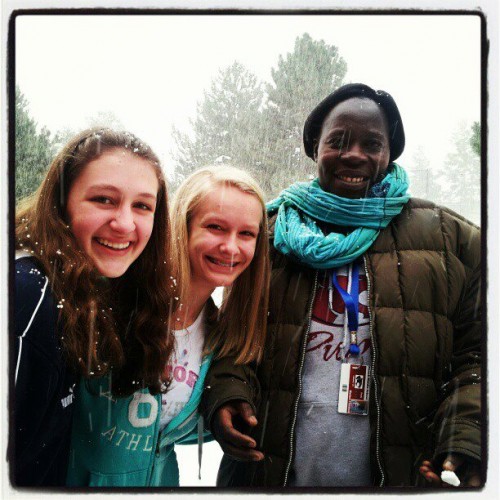
Snow!
January 14: Today I had a presentation with the Builders’ club (an after-school service club.) I spoke with them about Ugandan culture and Invisible Children. Specifically, I explained about the insurgency and the education system.
January 15: A working day as usual. I taught Humanity with Mrs. Erickson about rights and privileges and how those rights are abused at times. We were comparing the rights in both America and Uganda. During this lesson I realized a very big difference between the rights at home and the rights of Americans; especially in schools. The students’ reaction was that we in Uganda are still really behind because we do not have the privileges that they have here in the USA.
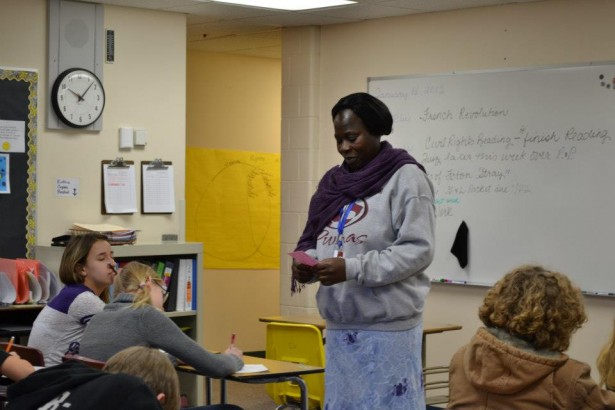
Teaching Humanities
January 16: A warm nice day. Had a Core lesson with Mrs. Toland. There was an Honor Roll Assembly for the students who received high marks in their classes for the first semester. This was amazing to see the turnout of the parents because so many of the parents were present and it is an indication that they love the school and it is a way of motivating the students to excel.
January 17: I worked a normal day. Friendly weather. Received two visiting friends from Uganda – Andrea and Haril from the organization called Musana. They are looking after orphans in Eastern Uganda. I was helped to improve on my typing skills which was very impressive. And this is one of the issues that the Invisible Children was advocating for…typing skills.
January 18: I got to teach about Uganda today in Humanities. We talked about the culture and I taught them how to do a Ugandan dance. The students really enjoyed. I am also crowned a purple lady who is rooting for the Baltimore Ravens.

Proof that dance is a universal language
And now we proudly introduce Samuel and the observations of his experience thus far.
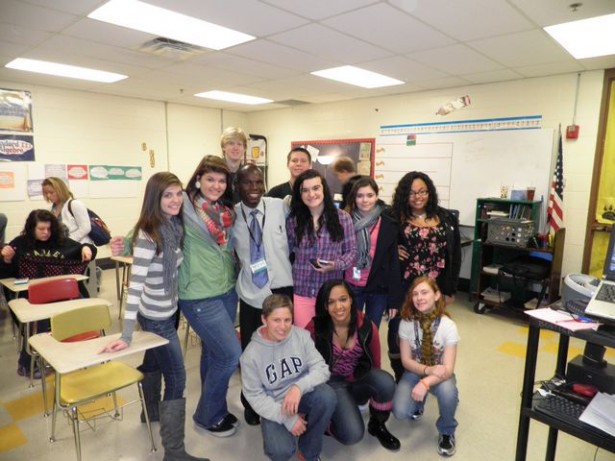
Samuel (middle, wearing tie) with some students
Class size: The number of students per class in Uganda is much greater as compared to this U.S. high school. I think the small family size here in USA is the major contributing factor to this and not underrating the greater number of schools existing in the States.
Subject contents:I have noted that the subject contents are similar irrespective of the country. It was very interesting to the students when I introduced Chemistry to them and realized that the same contents and applicability cut across. The mathematics learned in Uganda is not any different from that at this high school. Therefore, math’s languages are spoken universally.
Time management: I was very impressed how time is a factor of production (development) here in USA. Students can even leave you teaching in class if it is time for the next class. Everyone is mindful of time and so everything is done on the dot, no sparing a single second even for excuses. This is really superb and I hope every Ugandan could know these wonderful time management skills. Teachers are the best examples of time managers; every time they are in their classes waiting for students.
Electronic gadgets: All these are unacceptable in a Uganda school setting, as it’s believed that having all these technological unavoidable materials in place distract teaching and learning processes. I have been reliably informed that use the of calculators starts in low level education here and yet in Uganda, primary pupils may not know that there is a machine called CALCULATOR.
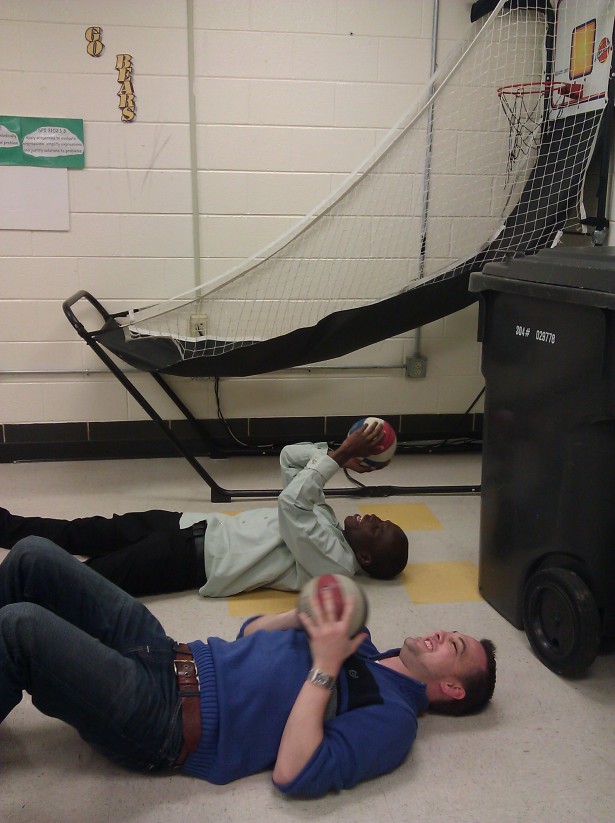
Samuel’s partner teacher showing him the proper way to shoot a basketball (which is clearly best shown by lying on the ground to learn the proper spin)
Discipline: For fear of being in the ISS (In-School Suspension) room, these high school students are disciplined and follow instructions perfectly. Throughout the week, less than 5 students were detained in the ISS room.
Dress code: This is strictly observed (collar shirts, ID on, etc). Violation of dress code can lead to pulling the student away from class.
Students’ lives: The teacher/student’ relationship is quite good. The students interact freely and amicably with their teachers. This significantly indicates the great love Americans have among themselves. There is only little authority over students by teachers as I initially imagine it would be like in Uganda. I think this has made life easy for the students.
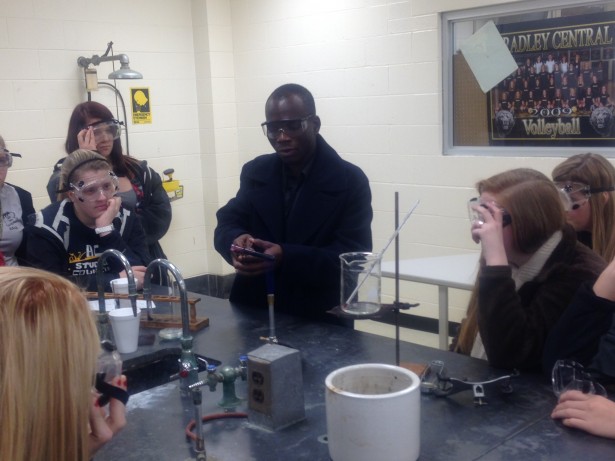
Working with students in the chemistry lab
Pedagogical practices: One interesting thing is that the U.S. uses a semester system as opposed to a term system of Uganda’s Secondary schools.
Did you know Math language can easily be danced? Here is a picture of me doing the “FOIL dance” – a simple way to memorize how to expand Binomial expressions of the form (x + 1)(2x +3) represented by (F O)(I L).
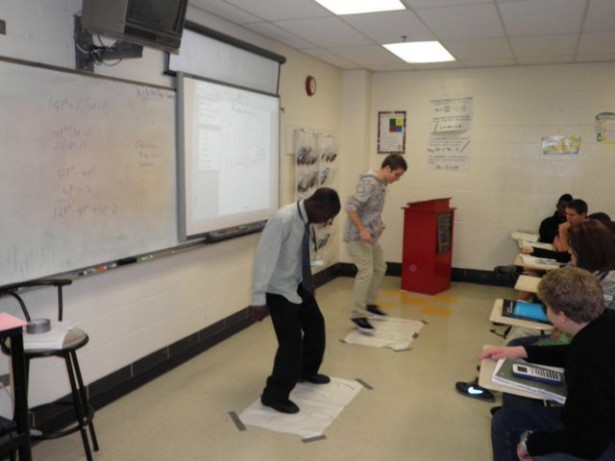
Do a little dance…
Learn all about Invisible Children’s Teacher Exchange Program HERE and stay tuned for highlights on the participants’ time outside the classroom.
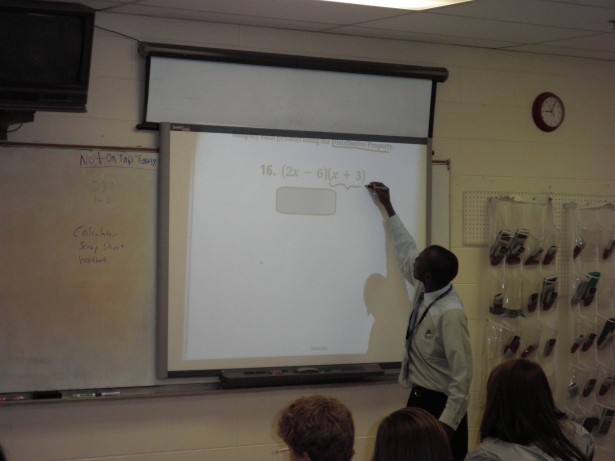
Think people should hear about this?